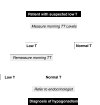A practical guide to male hypogonadism in the primary care setting
- PMID: 20518947
- PMCID: PMC2948422
- DOI: 10.1111/j.1742-1241.2010.02355.x
A practical guide to male hypogonadism in the primary care setting
Abstract
There is a high prevalence of hypogonadism in the older adult male population and the proportion of older men in the population is projected to rise in the future. As hypogonadism increases with age and is significantly associated with various comorbidities such as obesity, type 2 diabetes, hypertension, osteoporosis and metabolic syndrome, the physician is increasingly likely to have to treat hypogonadism in the clinic. The main symptoms of hypogonadism are reduced libido/erectile dysfunction, reduced muscle mass and strength, increased adiposity, osteoporosis/low bone mass, depressed mood and fatigue. Diagnosis of the condition requires the presence of low serum testosterone levels and the presence of hypogonadal symptoms. There are a number of formulations available for testosterone therapy including intramuscular injections, transdermal patches, transdermal gels, buccal patches and subcutaneous pellets. These are efficacious in establishing eugonadal testosterone levels in the blood and relieving symptoms. Restoration of testosterone levels to the normal range improves libido, sexual function, and mood; reduces fat body mass; increases lean body mass; and improves bone mineral density. Testosterone treatment is contraindicated in subjects with prostate cancer or benign prostate hyperplasia and risks of treatment are perceived to be high by many physicians. These risks, however, are often exaggerated and should not outweigh the benefits of testosterone treatment.
Figures



Comment in
-
Listen: testosterone is no longer a secret.Int J Clin Pract. 2010 May;64(6):663-4. doi: 10.1111/j.1742-1241.2010.02392.x. Int J Clin Pract. 2010. PMID: 20518942 No abstract available.
Similar articles
-
An update on male hypogonadism therapy.Expert Opin Pharmacother. 2014 Jun;15(9):1247-64. doi: 10.1517/14656566.2014.913022. Epub 2014 Apr 23. Expert Opin Pharmacother. 2014. PMID: 24758365 Free PMC article.
-
Transdermal testosterone gel improves sexual function, mood, muscle strength, and body composition parameters in hypogonadal men.J Clin Endocrinol Metab. 2000 Aug;85(8):2839-53. doi: 10.1210/jcem.85.8.6747. J Clin Endocrinol Metab. 2000. PMID: 10946892 Clinical Trial.
-
Late-onset hypogonadism.Med Clin North Am. 2011 May;95(3):507-23, x. doi: 10.1016/j.mcna.2011.03.001. Med Clin North Am. 2011. PMID: 21549875 Review.
-
Current status of testosterone replacement therapy in men.Arch Fam Med. 1999 May-Jun;8(3):257-63. doi: 10.1001/archfami.8.3.257. Arch Fam Med. 1999. PMID: 10333822 Review.
-
How to help the aging male? Current approaches to hypogonadism in primary care.Aging Male. 2012 Dec;15(4):187-97. doi: 10.3109/13685538.2012.729110. Epub 2012 Oct 15. Aging Male. 2012. PMID: 23067307 Review.
Cited by
-
Reversible effect of castration induced hypogonadism on the morphology of the left coronary arteries in adult male rabbits.Anat Cell Biol. 2024 Mar 31;57(1):61-69. doi: 10.5115/acb.23.196. Epub 2023 Nov 30. Anat Cell Biol. 2024. PMID: 38030134 Free PMC article.
-
Thyroid, cortisol and growth hormone levels in adult Nigerians with metabolic syndrome.Pan Afr Med J. 2017 Jan 31;26:52. doi: 10.11604/pamj.2017.26.52.9909. eCollection 2017. Pan Afr Med J. 2017. PMID: 28451029 Free PMC article.
-
Testosterone Pellet Associated Dermatitis: Report and Review of Testopel-related Cutaneous Adverse Effects.Cureus. 2017 Aug 11;9(8):e1560. doi: 10.7759/cureus.1560. Cureus. 2017. PMID: 29034138 Free PMC article.
-
Identifying the unmet supportive care needs of individuals affected by testicular cancer: a systematic review.J Cancer Surviv. 2024 Apr;18(2):263-287. doi: 10.1007/s11764-022-01219-7. Epub 2022 Jul 4. J Cancer Surviv. 2024. PMID: 35781623 Free PMC article.
-
Anthropometric, penile and testis measures in post-pubertal Italian males.J Endocrinol Invest. 2013 May;36(5):287-92. doi: 10.3275/8514. Epub 2012 Jul 9. J Endocrinol Invest. 2013. PMID: 22776895
References
-
- US Census Bureau . US Census Bureau; 2008. National Population Projections. [cited August 2008]; http://www.census.gov/population/www/projections/2008projections.html (Accessed 18 February 2010)
-
- Bhasin S, Cunningham GR, Hayes FJ, et al. Testosterone therapy in adult men with androgen deficiency syndromes: an endocrine society clinical practice guideline. J Clin Endocrinol Metab. 2006;91:1995–2010. - PubMed
-
- Petak SM, Nankin HR, Spark RF, et al. American Association of Clinical Endocrinologists Medical Guidelines for clinical practice for the evaluation and treatment of hypogonadism in adult male patients – 2002 update. Endocr Pract. 2002;8:440–56. - PubMed
-
- Wang C, Nieschlag E, Swerdloff R, et al. Investigation, treatment, and monitoring of late-onset hypogonadism in males: ISA, ISSAM, EAU, EAA, and ASA recommendations. J Androl. 2009;30:1–9. - PubMed
-
- Morales A, Schulman CC, Tostain J, F CWW. Testosterone Deficiency Syndrome (TDS) needs to be named appropriately – the importance of accurate terminology. Eur Urol. 2006;50:407–9. - PubMed
Publication types
MeSH terms
Substances
Grants and funding
LinkOut - more resources
Full Text Sources
Other Literature Sources
Research Materials

